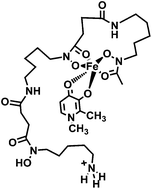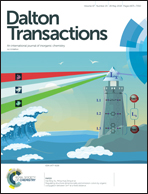The kinetics of dimethylhydroxypyridinone interactions with iron(iii) and the catalysis of iron(iii) ligand exchange reactions: implications for bacterial iron transport and combination chelation therapies†
Abstract
Many microbes acquire environmental Fe by secreting organic chelators, siderophores, which possess the characteristics of a high and specific binding affinity for iron(III) that results in the formation of thermodynamically stable, and kinetically inert iron(III) complexes. Mechanisms to overcome the kinetic inertness include the labilization of iron(III) by means of ternary complex formation with small chelators. This study describes a kinetic investigation of the labilization of iron(III) between two stable binding sites, the prototypical siderophore ferrioxamine B and EDTA, by the bidentate siderophore mimic, 1,2-dimethyl-3-hydroxy-4-pyridinone (L1, H(DMHP)). The proposed mechanism is substantiated by investigating the iron(III) exchange reaction between ferrioxamine B and H(DMHP) to form Fe(DMHP)3, as well as the iron(III) exchange from Fe(DMHP)3 to EDTA. It is also shown that H(DMHP) is a more effective catalyst for the iron(III) exchange reaction than bidentate hydroxamate chelators reported previously, supporting the hypothesis that chelator structure and iron(III) affinity influence low denticity ligand facilitated catalysis of iron(III) exchange reactions. The results are also discussed in the context of the design and use of combination chelator therapies in the treatment of Fe overload in humans.



 Please wait while we load your content...
Please wait while we load your content...
